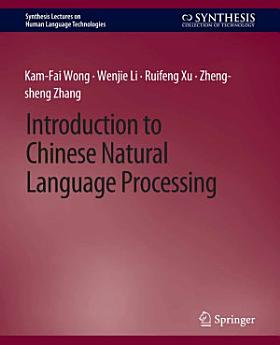Introduction to Chinese Natural Language Processing
જૂન 2022 · Springer Nature
ઇ-પુસ્તક
148
પેજ
reportરેટિંગ અને રિવ્યૂ ચકાસેલા નથી વધુ જાણો
આ ઇ-પુસ્તક વિશે
This book introduces Chinese language-processing issues and techniques to readers who already have a basic background in natural language processing (NLP). Since the major difference between Chinese and Western languages is at the word level, the book primarily focuses on Chinese morphological analysis and introduces the concept, structure, and interword semantics of Chinese words. The following topics are covered: a general introduction to Chinese NLP; Chinese characters, morphemes, and words and the characteristics of Chinese words that have to be considered in NLP applications; Chinese word segmentation; unknown word detection; word meaning and Chinese linguistic resources; interword semantics based on word collocation and NLP techniques for collocation extraction. Table of Contents: Introduction / Words in Chinese / Challenges in Chinese Morphological Processing / Chinese Word Segmentation / Unknown Word Identification / Word Meaning / Chinese Collocations / Automatic Chinese Collocation Extraction / Appendix / References / Author Biographies
લેખક વિશે
Kam-Fai Wong obtained his Ph.D. from Edinburgh University, Scotland, in 1987. At present, he is a professor in the Department of Systems Engineering and Engineering Management, the Chinese University of Hong Kong (CUHK) as well as an adjunct professor of Northeastern University and Peking University, China. His research interest centers on Chinese computing, parallel database and information retrieval. He has published over 200 technical papers in these areas in various international journals and conferences and books. He is the founding Editor-In-Chief of ACM Transactions on Asian Language Processing (TALIP), a co-editor-in-chief of International Journal on Computer Processing of Oriental Languages, and a member of the editorial board of the Journal on Distributed and Parallel Databases, International Journal on Computational Linguistics and Chinese Language Processing and Journal of Chinese Processing (China). He is the conference co-chair of APWeb'08, Shenyang and AIRS'2008, Harbin,China; Program Co-chair of IJCNLP'2005, Jeju, Korea; and panel co-chair of VLDB2002.
આ ઇ-પુસ્તકને રેટિંગ આપો
તમે શું વિચારો છો અમને જણાવો.
માહિતી વાંચવી
સ્માર્ટફોન અને ટૅબ્લેટ
Android અને iPad/iPhone માટે Google Play Books ઍપ ઇન્સ્ટૉલ કરો. તે તમારા એકાઉન્ટ સાથે ઑટોમૅટિક રીતે સિંક થાય છે અને તમને જ્યાં પણ હો ત્યાં તમને ઑનલાઇન અથવા ઑફલાઇન વાંચવાની મંજૂરી આપે છે.
લૅપટૉપ અને કમ્પ્યુટર
Google Play પર ખરીદેલ ઑડિઓબુકને તમે તમારા કમ્પ્યુટરના વેબ બ્રાઉઝરનો ઉપયોગ કરીને સાંભળી શકો છો.
eReaders અને અન્ય ડિવાઇસ
Kobo ઇ-રીડર જેવા ઇ-ઇંક ડિવાઇસ પર વાંચવા માટે, તમારે ફાઇલને ડાઉનલોડ કરીને તમારા ડિવાઇસ પર ટ્રાન્સફર કરવાની જરૂર પડશે. સપોર્ટેડ ઇ-રીડર પર ફાઇલો ટ્રાન્સ્ફર કરવા માટે સહાયતા કેન્દ્રની વિગતવાર સૂચનાઓ અનુસરો.






